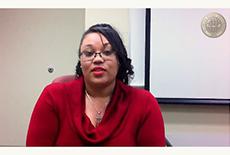Students tell the stories of the uninsured among us


Many of us hear the phrase “the uninsured” and picture faceless crowds of unfortunate people who are nothing like us. In February, for this year’s observance of Cover the Uninsured Week (CTUW), student organizers created a video that reveals the faces of people just like us who were or are uninsured.
In fact, some of them really are us. Seven of the 10 people interviewed were either medical or Bridge students at the College of Medicine.
“I was uninsured most of my life,” said Travisha Vaughns (pictured right), a second-year student and one of the CTUW organizers. “A lot of my health care was from hospital visits, and those were severe instances.”
Vaughns appears in the 12-minute video, “The Face of the Uninsured,” a CTUW project on which second-year student Angelina Malamo took the lead. She and event co-organizers Ariel Hoffman and Stacy Ranson, also second-year students, were inspired by the documentary “Escape Fire: The Fight to Rescue American Healthcare,” which was screened for students last year.
“The three of us were just so moved,” Malamo said. “For me, it shaped the way I thought, and the way I was moving forward with studies and with my interests in the medical field.”
Three of the 10 people interviewed for the video live or work at Maryland Oaks Crossing, a transitional housing community where College of Medicine students regularly visit and provide health screenings. One Maryland Oaks employee said on the video that he’d like a doctor to investigate his throat problems but he can’t afford it.
Elsewhere on the video, when asked to sum up life without health insurance in three words, one person said, “Don’t get ill.”
Cover the Uninsured Week is a national effort observed annually at the College of Medicine. This year's event included discussions about what it means to be uninsured, what you can do to help, a "Jeopardy?"-style event and a Chapman Community health screening. The goal is to raise awareness of the burden and hardship millions of Americans face in finding health care for themselves and their families. Although each U.S. citizen is now required to carry health insurance, many remain un- or underinsured.
“Health care isn't free,” Vaughns said. “Even if you qualify for Obamacare, you still have to pay the bill each month, and if you can't, you are not insured. Thank goodness my mom was able to qualify recently for a free plan with a minimal co-pay. She can finally be seen for the first time in years. My sister still doesn't qualify and continues to use the emergency room for care.”
These insurance discussions force medical students to consider how they’ll handle this issue when they enter medical practice. CTUW faculty sponsor Daniel Van Durme underscored the idea of compassionate care and serving the underserved. In response to one student’s question about whether physicians could afford to treat the uninsured in private practice, Van Durme replied: “How much money do you need to live on? Is $250,000 a year enough?”
Malamo elaborated on that theme. “I think some students have the idea that seeing uninsured patients will cause a private practice to have to close its doors,” she said. “You can still help out many uninsured people by just making some financial sacrifices. There definitely is a balance, but if every physician made a small sacrifice, we could serve an incredible number of uninsured patients.”

